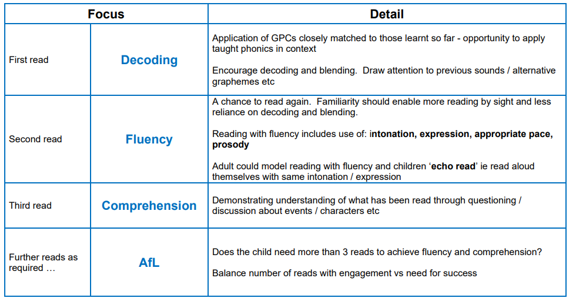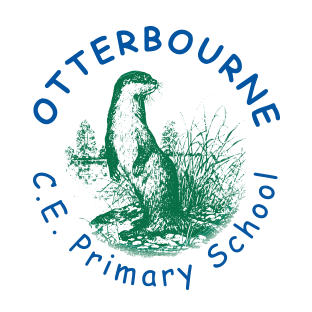Reading At Otterbourne CE Primary School
Reading is fundamental to education. Proficiency in reading, writing and spoken language is vital for pupils’ success. Through these, they develop communication skills for education and for working with others: in school, in training and at work. Pupils who find it difficult to learn to read are likely to struggle across the curriculum, since English is both a subject in its own right and the medium for teaching. This is why the government is committed to continuing to raise standards of literacy for all.
(DfE Reading Framework 2023)
Phonics and Early Reading Teaching and Learning Approach
At Otterbourne Church of England Primary School, we strive to foster a love for reading for all children from the very beginning. The first thing that the children (and visitors to the school) see when entering the building is a bright, spacious library, with well stocked shelves and a variety of books to suit all tastes. From the beginning of Year R, the children visit the library on a weekly basis to explore the books and take some home, using their own library card.


Throughout their time with us, children are actively encouraged to read: often, regularly and with increasingly more challenging texts – at home and at school. Independent (quiet) reading for pleasure, paired reading, adult-led reading with individual children, in small groups or with whole classes are all planned in at school. The children have a range of reading materials available to them including books, magazines, websites and posters. Our priority is get children confident, get them engaged and then get them excited about reading.
The start of the reading journey is the teaching of phonics and giving children the experience of early reading. Getting to know the format of a book: the cover, title, contents, main pages and supporting images, and simply how to turn the pages are part of that, and the word reading starts with phonics.
From the very start of Year R, the children and parents are introduced to our school SSP (Systematic, Synthetic Phonics) programme, Bug Club. Bug Club follows a consistent approach for each taught sound. The children explore the sound through: a clear introduction, a visual search of the sound in words, reading the sound in different words, spelling words that contain the sound, writing and a follow-up activity, usually a dictation.
The children work through the phases of Bug Club in Year R and Year One. Daily phonics teaching is the key to success when it comes to supporting our children to read. In Year R and Year One, phonics is prioritised in the timetable. In addition, the sounds and tricky words learnt in Bug Club lessons are consolidated through well-developed enhanced and continuous provision opportunities, and adults identify when there is an incidental learning opportunity through the children’s play-based learning.
There is a clear progression with phonics which we follow in line with the Bug Club planning.

Phases covered in Year R

Phases covered in Year One

Early identification is key in recognising when a child needs support to keep up with their phonics learning. Regular assessments in class ensure children are on track with their phonics and extra support is put in place straightaway to avoid a child falling behind. In Year R and Year One, this is carried out through small group or 1:1 revision of the sounds the child is not secure on, as well as pinpointed revision in whole class lessons.
At the end of Year One, children will sit through a phonics screen, which is a statutory test to assess their knowledge and understanding of phonics. This test consists of a list of 40 words that the child reads aloud. Half the words are ‘real’ words and the other half are made up ‘pseudo-words’ which are demarcated by a cartoon alien. Children who don’t meet the benchmark (pass rate) are supported through a small group intervention called Rapid Phonics which links with Bug Club. This helps the children to learn any missing sounds or consolidate knowledge through a multi-sensory approach with repetition.
Early Reading at School – Year R
From the beginning of Year R, children are given a Bug Club non-word book which is shared in class either in small groups or 1:1 as appropriate. This is to build on the children’s listening and attention skills from pre-school learning in Phase 1 phonics.
As they develop a greater understanding of phonemic awareness and become more confident in blending sounds together to make words and sentences, children are supported with a Bug Cub reading book that is matched to their level of understanding. Children will begin reading their books 1:1 with an adult. When they are deemed able to follow others’ reading with their finger and are able to share reading in a group, the 1:1 sessions will change to group reading sessions depending on the sounds the children know. All sessions focus on either decoding, fluency or comprehension.
Early Reading at School – Year One
Children in Year One will take part in group Guided Reading sessions four times a week. The books for each groups are matched to the sounds the children know. All sessions focus either on decoding, fluency or comprehension.
Reading at School – Year Two
Children in Year Two continue to take part in small group guided reading sessions. All children in Year R to Year 2 follow the Carousel 'Three-Reads' approach.

In KS1, children also have daily teacher reading time where the class reading book exposes children to high quality texts.
Reading at School – KS2
In Key Stage Two, children begin whole class guided reading sessions. These sessions follow a four-step approach.

In addition, there is regular reading and discussion of a class novel, which we have multiples copies of, allowing children to immerse themselves in the story whilst developing fluency and comprehension.
Reading is at the heart of our English curriculum. Our long-term plans contains core set of high-quality texts for each year group and outline full curriculum coverage. Please click on our English Curriculum documents to see our full range of text drivers which follow our school Curriculum Pillars and English Golden Threads.

Reading at Home
Reading is a life skill and in order for children to meet their full potential, opportunities for reading need to be identified at home as well as at school. Regular, short reading sessions will always be more effective than long, infrequent sessions as the children build their skills. In Year R and Year One, reading at home is the main homework given. Children are provided with a Bug Club book each week which they will already be familiar with from their Guided Reading sessions. Children also have access to a wide range of Bug Club books online matched to the sounds the children are confident with.
Each class (Year R to 4) has a weekly scheduled library time which allows them to choose and read books for pleasure and our older children (Years 5-6) are given the freedom to use the library whenever they need to change their books. In addition to this, each class has a book corner where children are further invited to explore and select books. KS2 children always have a class reading book available which they can access in quiet reading time. Children are expected to read at home at least five times a week. This is closely monitored and is rewarded through the use of house points. Reads are recorded in Reading Diaries (Years R to 4) and, in order to develop independence and maintain enthusiasm, this extends to Boom Reader (Years 5-6). Both are checked regularly by teachers.
